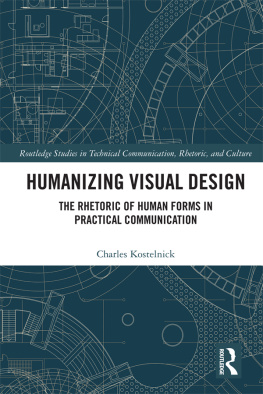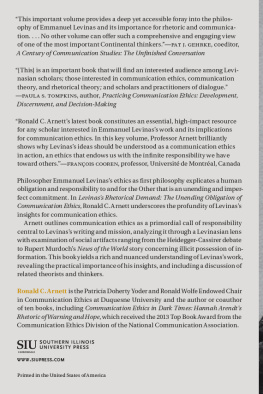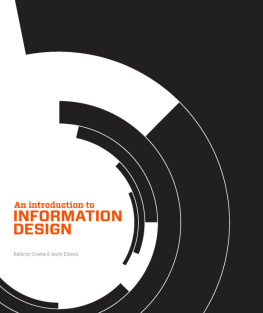Humanizing Visual Design
This book analyzes the role that human forms play in visualizing practical information and in making that information understandable, accessible, inviting, and meaningful to readersin short, humanizing it.
Although human figures have long been deployed in practical communication, their uses in this context have received little systematic analysis. Drawing on rhetorical theory, art history, design studies, and historical and contemporary examples, the book explores the many rhetorical purposes that human forms play in functional pictures, including empowering readers, narrating processes, invoking social and cultural identities, fostering pathos appeals, and visualizing data.
The book is aimed at scholars, teachers, and practitioners in business, technical, and professional communication as well as an interdisciplinary audience in rhetoric, art and design, journalism, engineering, marketing, science, and history.
Humanizing Design is destined to become an essential book for anyone serious about the study of the human figure in functional communication. Drawing on a wide range of historical and contemporary images, Charles Kostelnick argues persuasively that human figures in design are essential to understanding processes and stories.
Marguerite Helmers, author of Defining Visual Rhetorics
Charles Kostelnick is a professor at Iowa State University, where he has taught courses in business and technical communication for three decades. He has published several articles and book chapters on visual communication, as well as co-authored Shaping Information: The Rhetoric of Visual Conventions (2003) and Designing Visual Language: Strategies for Professional Communicators (second edition, 2011) and co-edited Visible Numbers: Essays in the History of Statistical Graphics (2016). He served as editor and co-editor of the Journal of Business and Technical Communication.
Routledge Studies in Technical Communication, Rhetoric, and Culture
Series Editors: Miles A. Kimball and Charles H. Sides
This series promotes innovative, interdisciplinary research in the theory and practice of technical communication, broadly conceived as including business, scientific, and health communication. Technical communication has an extensive impact on our world and our lives, yet the venues for long-format research in the field are few. This series serves as an outlet for scholars engaged with the theoretical, practical, rhetorical, and cultural implications of this burgeoning field. The editor welcomes proposals for book-length studies and edited collections involving qualitative and quantitative research and theoretical inquiry into technical communication and associated fields and topics, including user-centered design; information design; intercultural communication; risk communication; new media; social media; visual communication and rhetoric; disability/accessibility issues; communication ethics; health communication; applied rhetoric; and the history and current practice of technical, business, and scientific communication.
Writing Postindustrial Places
Technoculture amid the Cornfields
Michael J. Salvo
Scientific Communication
Practices, Theories, and Pedagogies
Edited by Han Yu and Kathryn Northcut
Commonplaces of Scientific Evidence in Environmental Discourses
Denise Tillery
Posthuman Praxis in Technical Communication
Edited by Kristen R. Moore and Daniel P. Richards
Humanizing Visual Design
The Rhetoric of Human Forms in Practical Communication
Charles Kostelnick
For a full list of titles in this series, please visit www.routledge.com
Humanizing Visual Design
The Rhetoric of Human Forms in Practical Communication
Charles Kostelnick

First published 2019
by Routledge
52 Vanderbilt Avenue, New York, NY 10017
and by Routledge
2 Park Square, Milton Park, Abingdon, Oxon OX14 4RN
Routledge is an imprint of the Taylor & Francis Group, an informa business
2019 Taylor & Francis
The right of Charles Kostelnick to be identified as author of this work has been asserted by him in accordance with sections 77 and 78 of the Copyright, Designs and Patents Act 1988.
All rights reserved. No part of this book may be reprinted or reproduced or utilised in any form or by any electronic, mechanical, or other means, now known or hereafter invented, including photocopying and recording, or in any information storage or retrieval system, without permission in writing from the publishers.
Trademark notice: Product or corporate names may be trademarks or registered trademarks, and are used only for identification and explanation without intent to infringe.
Library of Congress Cataloging-in-Publication Data
A catalog record for this book has been requested
ISBN: 978-1-138-07151-3 (hbk)
ISBN: 978-1-315-11462-0 (ebk)
Typeset in Sabon
by Apex CoVantage, LLC
To the many members of my family, especially my parents, Julius and Marcella Kostelnick, who taught me how to make my way in the world, and my wife, Clare, and our children and grandchildren, whom I hope to inspire in similar ways.
Charles Kostelnick
Contents
.
.
.
.
.
.
.
.
.
.
.
.
.
.
.
.
.
.
.
.
.
.
.
.
.
.
.
.
.
.
.
.
.
.
.
.
.
.
.
.
.
.
.
.
.
.
.
.
.
.
.
.
.
.
.
.
.
.
.
.
.
.
.
.
.
.
.
.
.
.
.
.
.
.
.
.
.
.
.
.
.
.
.
.
.
.
.
.
.
.
.
.
.
.
.
.
.
.
.
.
.
.
.
.
.
.
.
.
.
.
.
.
.
.
.
Visual rhetoric has become a major area of study in several cognate fields, ranging from writing, information design, and data visualization to business, technical, and professional communication and related fields like architecture and product design. This book is intended to contribute to this growing realm of rhetorical studies in applied communication by focusing on one of its most prevalent, long-standing, and fundamental elements: the human form.
Such an enterprise opens before a scholar like a lush, expansive valley fed by endless streams, thick with vegetation, and wild and uncharted. At the same time, this kind of undertaking is fraught with difficulty, given both the variegated complexity of that landscape and the growing number of practical and theoretical lenses with which to explore and interpret it. So like any explorer, the scholar needs to be selective, to choose the interpretive tools that can best survey the territory, knowing that alternate paths might have been taken but certain nonetheless that those will offer productive avenues for others to explore in the future.
So, too, like an expedition through such a vast territory, I discovered material that provided contextual richness and depth to my study: historical examples I found in early books and in digital collections, warnings I observed on equipment, novel signs I encountered in public spaces, and a plenitude of other images I encountered and sometimes recorded, and then left in the files, gradually realizing that the surfeit extended well beyond the bounds of a single book. Those experiences also kept me wondering what remains undiscovered in obscure archives, files, books, and manuals, both nearby and in places around the globe I have yet to explore. That awareness is both the rewardand the relentless challengeof writing a book on a subject as fertile and wide-ranging as this one.













